
A customer’s car buying journey is long, complicated, and affected by changes in technology and automotive trends. To help your dealership keep up in an ever-changing industry, we’ve compiled some of the latest automotive marketing statistics. Keep reading to get started.

1. According to DialogTech, Pay Per Click (PPC) ads account for 66% of automotive calls generated by search engines. Organic search accounts for the other 34%.
Paid search plays a major role in automotive marketing. The strongest player here is Google Ads, which is formerly known as Google AdWords, but other strong players include Facebook ads and Instagram ads. The good news is that AutoJini has 20+ years of digital marketing experience tailored specifically for automotive dealerships. For more information on our PPC services, click here
2. In 2018, electronic car sales grew by 75%, according to JATO.
Battery-powered vehicles and hybrid electric cars are becoming more popular. Part of this has to do with how they’re promoted as being more environmentally friendly, and another part of this has to do with the diesel crisis. With growing technology, electric cars have become more affordable, easier to access, and easier to charge. Public charging stations for electric cars are popping up all across the United States and Europe. Do you have electric cars on your lot?
3. 78% of local searches made on a mobile device result in an offline purchase, according to comScore. Furthermore, this purchase usually happens within a few hours of the search.
Local search is a powerful strategy to use when you market your dealership. There are many ways to improve your local SEO, from managing local listings to optimizing your site content.
4. There are 1.4 million more women than men with drivers’ licenses, according to CBS News.
A lot of people make the assumption that men are more interested in cars than women are, but there are more women driving on the road. Women and men react differently to marketing messages. While men tend to value luxury, appearance, and the technology of their cars, women tend to prefer durability, safety, and affordability. Are you effectively advertising your vehicles to women car buyers?
5. Half of all searches are expected to be voice-based by 2020. With the rise in virtual assistants such as Siri, Alexa, Google Home, and more, voice search is on the rise… and fast. There are different ways to optimize your dealership website for voice search. To learn more, check out our blog post, “5 Ways to Optimize Your Dealer Website for Voice Search.”
6. Fewer lower-priced vehicles are available, according to Edmunds. However, low-priced vehicles sell quickly.
The lack of older vehicles is largely caused by the decline in new car sales during the recession. What does this mean? Take advantage of the scarcity in used vehicles and shift your marketing efforts to your pre-owned vehicles.
7. According to Cox Auto Inc, new vehicle sales fell nearly 2% in 2017.
Going off of our previous data, while lower-priced vehicles are selling quickly, new vehicles are not selling as well as they did. This is more of a reason to really focus on advertising your pre-owned cars. Car buyers spend a lot more time looking at the details of a used car than they do a used car because of factors like vehicle history reports, mileage, and more. Customers want to have easy access to all this information or else they may look elsewhere.
How are you showcasing your used vehicles? AutoJini’s inventory management system lets you display your cars online with high-resolution images, prices, vehicle specs, free window stickers, and we’ll export your inventory to over 100+ data partners.
8. Ride-sharing apps like Uber and Lyft may affect younger car buyers, but overall, they do not have a huge effect on car sales.
Many people worry that with apps such as Uber, Lyft, and other smartphone taxi services that people will ditch their cars. Taxi services can be convenient, but they don’t replace the experience of owning a car. In big urban cities like New York City, these services may be able to replace car ownership. However, everywhere else, it is actually cheaper just to own a car. There are also trips such as vacations, visits back home, and more that still require the ownership or leasing of a vehicle.
9. There is a 29% increase in purchase consideration when television advertisements and social media are used together, according to Nielsen’s 2018 auto marketing report.
With the rise in streaming services like Netflix and Hulu, a lot of people have been ditching cable television. This may lead to the assumption that tv ads are no longer effective, but this statistic proves that to be false. There are still people watching cable tv, and cable tv is what’s usually played at restaurants, stores, and more. And of course, the rise of social media brings us to the importance of social media marketing.
The bottom line is: don’t let the popularity of Uber and Lyft discourage you from your marketing efforts.
It’s not too late to get started on your car marketing campaign or to improve your existing one. AutoJini is a leader in digital marketing services tailored for automotive dealers. From Pay Per Click management, SEO, email marketing, branding, and more, we’ve got you covered with over 20 years of experience and talented experts on our team.

